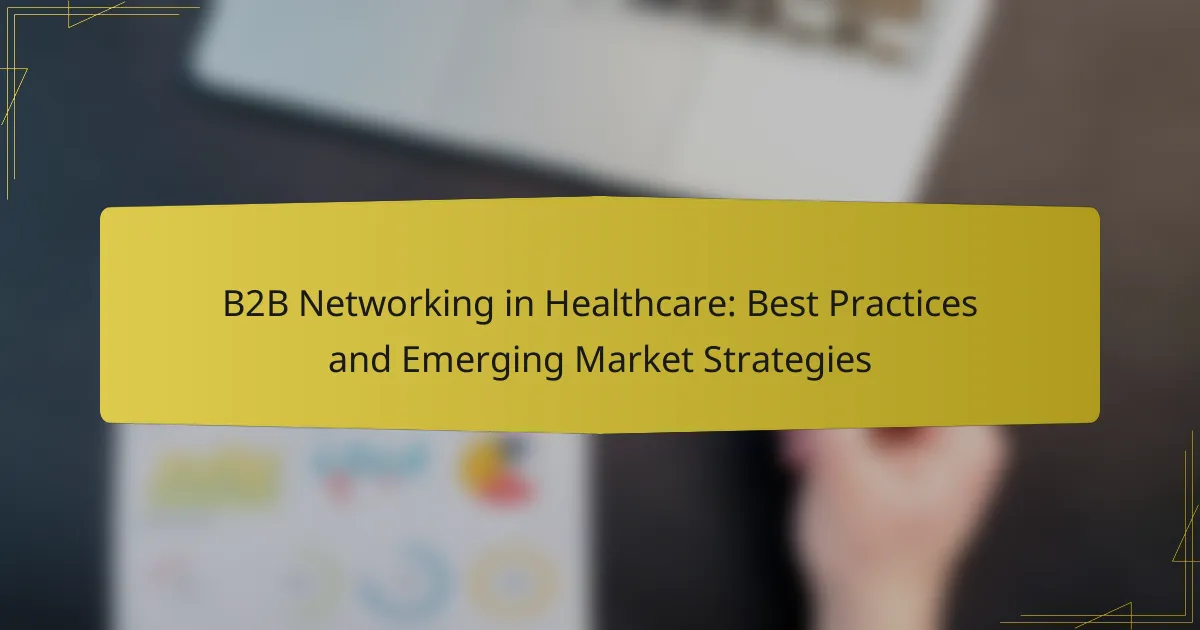B2B networking in healthcare is crucial for fostering strong relationships and driving growth through trust and collaboration. By leveraging technology and engaging in targeted outreach, organizations can enhance their networking strategies and build meaningful connections within the industry. Emphasizing transparency and long-term engagement will further improve collaboration and resource sharing among healthcare professionals.
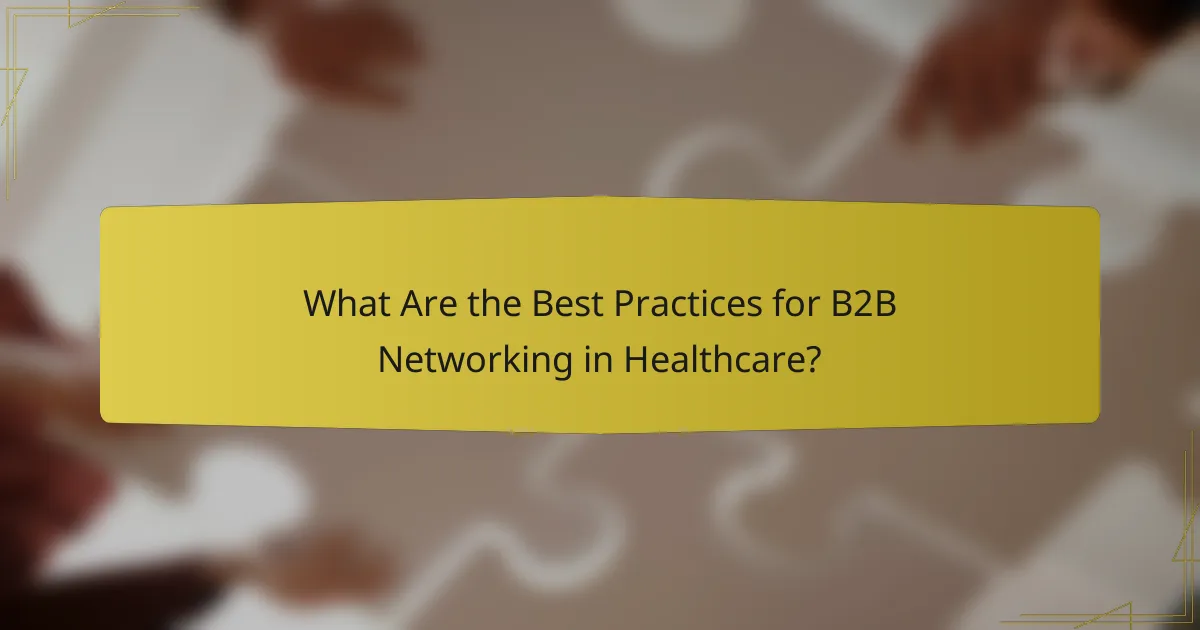
What Are the Best Practices for B2B Networking in Healthcare?
Effective B2B networking in healthcare involves building strong relationships, fostering trust, and leveraging various platforms and events. By focusing on transparency, collaboration, and long-term engagement, businesses can enhance their networking efforts and drive growth.
Building Trust Through Transparency
Trust is essential in healthcare networking, where stakeholders must rely on each other’s integrity. Being transparent about your services, pricing, and capabilities helps establish credibility and fosters open communication.
Provide clear information about your business practices and be upfront about any limitations. This honesty can differentiate your organization and attract partners who value ethical collaboration.
Leveraging Industry Events
Industry events, such as conferences and trade shows, are prime opportunities for B2B networking in healthcare. Attending these gatherings allows businesses to meet potential partners, learn about market trends, and showcase their offerings.
To maximize your presence, prepare in advance by scheduling meetings and creating a list of key contacts. Follow up promptly after the event to solidify connections and explore collaboration opportunities.
Utilizing Digital Platforms
Digital platforms play a crucial role in modern B2B networking. Websites like LinkedIn and industry-specific forums enable healthcare professionals to connect, share insights, and engage in discussions.
Regularly update your online profiles and participate in relevant conversations to enhance visibility. Consider joining groups focused on healthcare innovation or regulatory changes to stay informed and network with like-minded professionals.
Fostering Long-term Relationships
Building long-term relationships is vital for sustained success in healthcare networking. Regular communication, personalized outreach, and continued engagement can help maintain these connections over time.
Consider scheduling periodic check-ins or sharing valuable resources with your contacts. This approach not only strengthens relationships but also positions your organization as a trusted partner in the industry.
Engaging in Collaborative Projects
Collaborative projects can enhance B2B networking by creating shared goals and mutual benefits. Partnering with other organizations on research, product development, or community initiatives can lead to innovative solutions and expanded networks.
Identify potential collaborators whose strengths complement your own, and propose joint ventures that align with both parties’ objectives. This strategy can lead to valuable insights and increased visibility within the healthcare sector.
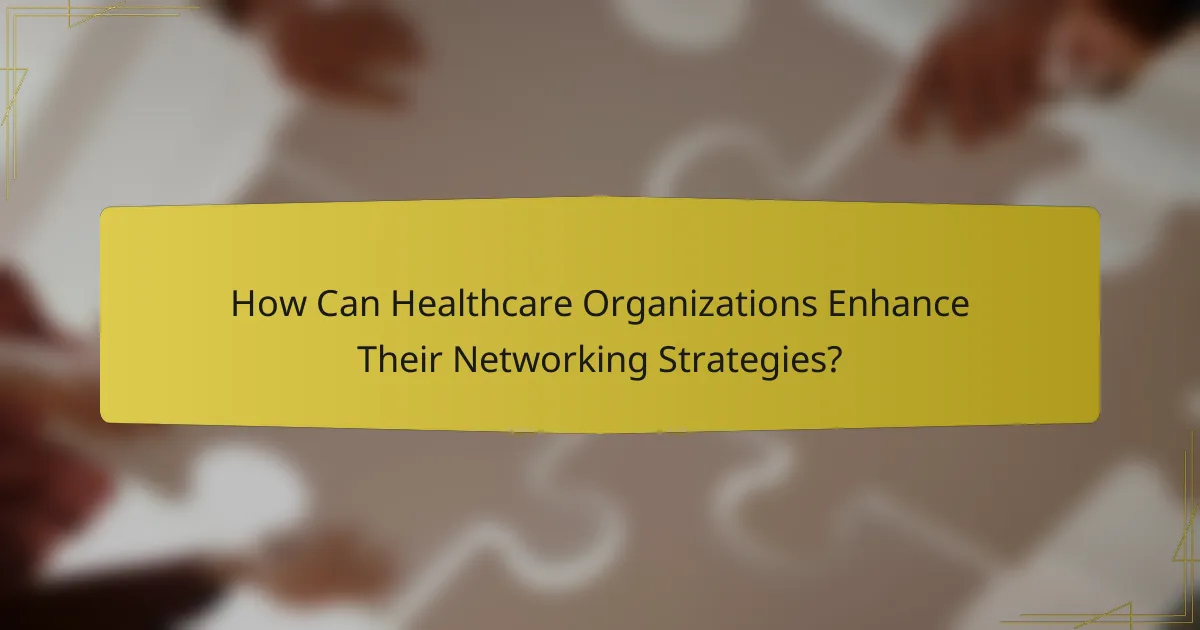
How Can Healthcare Organizations Enhance Their Networking Strategies?
Healthcare organizations can enhance their networking strategies by leveraging technology, fostering relationships, and engaging in targeted outreach. By implementing effective systems and participating in relevant associations, they can build stronger connections and improve collaboration within the industry.
Implementing CRM Systems
Customer Relationship Management (CRM) systems are essential for healthcare organizations to manage interactions with partners and clients efficiently. These systems help track communications, streamline processes, and analyze data to improve relationship management.
When selecting a CRM, consider features like integration with existing systems, user-friendliness, and scalability. Popular options in the healthcare sector include Salesforce Health Cloud and HubSpot, which can be tailored to meet specific needs.
Developing Targeted Outreach Programs
Targeted outreach programs enable healthcare organizations to connect with specific demographics or sectors, enhancing networking effectiveness. These programs should be based on thorough market research to identify key stakeholders and tailor messaging accordingly.
Consider using a mix of digital marketing, webinars, and in-person events to engage your audience. For instance, hosting educational webinars on emerging healthcare trends can attract potential partners and clients while showcasing your expertise.
Participating in Professional Associations
Joining professional associations is a strategic way for healthcare organizations to expand their networks. These associations often provide access to valuable resources, industry insights, and networking opportunities with peers and leaders in the field.
Look for associations relevant to your specialty, such as the American Hospital Association or the Healthcare Information and Management Systems Society. Active participation, such as attending conferences or contributing to discussions, can significantly enhance visibility and relationships within the industry.
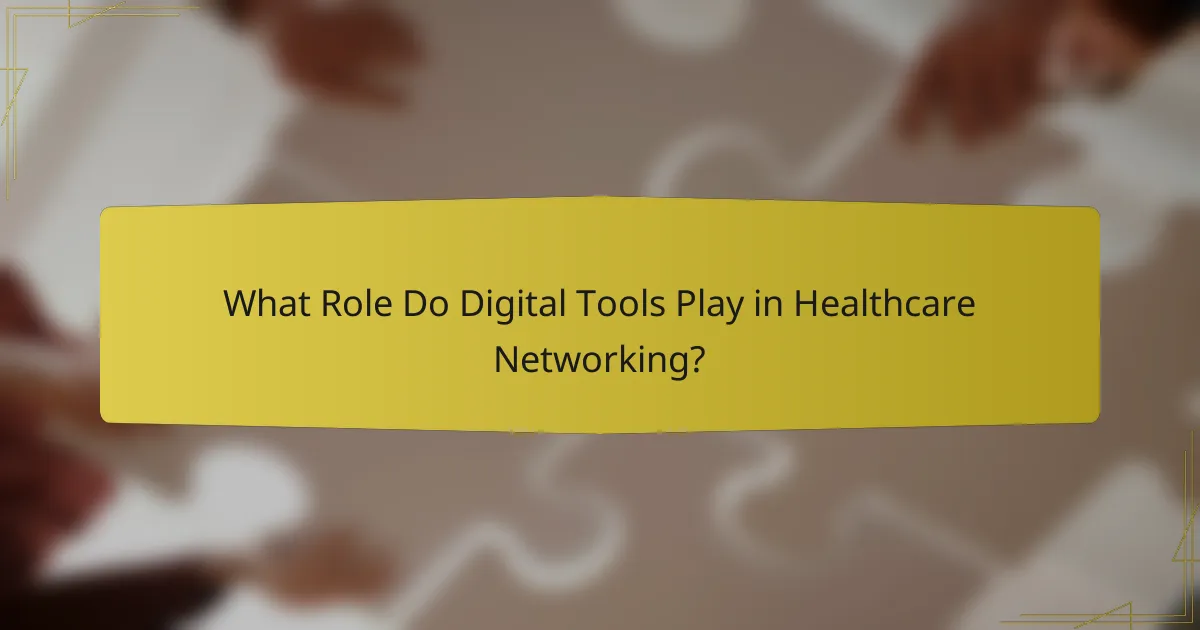
What Role Do Digital Tools Play in Healthcare Networking?
Digital tools are essential for enhancing networking in the healthcare sector, facilitating connections and collaborations among professionals. They streamline communication, improve access to information, and enable the sharing of resources across various platforms.
Using LinkedIn for Professional Connections
LinkedIn serves as a powerful platform for healthcare professionals to build and maintain their networks. Users can connect with peers, join industry-specific groups, and share insights, which can lead to valuable partnerships and opportunities.
To maximize LinkedIn’s potential, regularly update your profile with relevant experiences and skills. Engage with content by commenting and sharing, which can increase visibility and attract connections in your field.
Employing Virtual Networking Events
Virtual networking events have become a popular way for healthcare professionals to connect without geographical limitations. These events often include webinars, panel discussions, and breakout sessions that facilitate interaction among participants.
When attending virtual events, prepare by researching speakers and topics in advance. Actively participate by asking questions and following up with connections afterward to solidify relationships.
Adopting Telehealth Platforms for Collaboration
Telehealth platforms enable healthcare professionals to collaborate efficiently, especially in multidisciplinary teams. These tools allow for real-time consultations, sharing of patient information, and joint decision-making, which can enhance patient care.
When selecting a telehealth platform, consider factors such as user-friendliness, compliance with regulations like HIPAA, and integration capabilities with existing systems. Regular training and updates can help ensure that all team members are proficient in using these tools effectively.
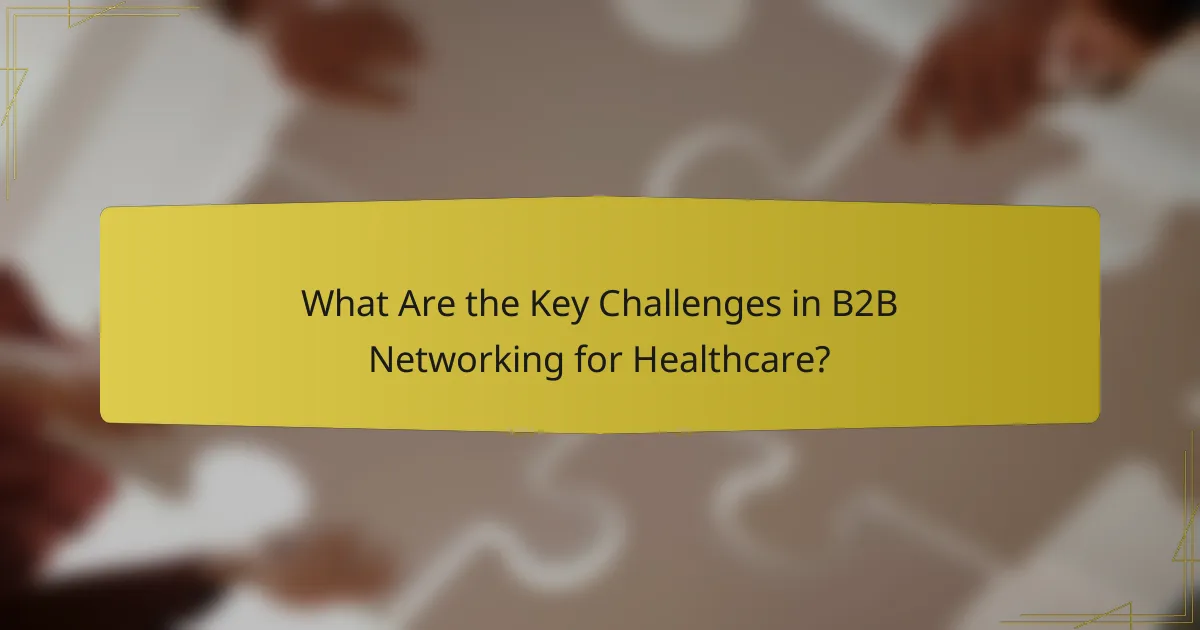
What Are the Key Challenges in B2B Networking for Healthcare?
B2B networking in healthcare faces several key challenges, including navigating complex regulations, ensuring data privacy, and addressing the diverse needs of stakeholders. These factors can significantly impact collaboration and partnership opportunities within the industry.
Navigating Regulatory Compliance
Regulatory compliance is a major challenge in B2B networking for healthcare. Companies must adhere to various laws and standards, such as HIPAA in the United States or GDPR in Europe, which govern patient information and data handling. Understanding these regulations is crucial to avoid legal pitfalls and ensure smooth operations.
To effectively navigate compliance, organizations should invest in training and resources that keep their teams updated on relevant regulations. Regular audits and consultations with legal experts can also help identify potential compliance gaps and mitigate risks.
Overcoming Data Privacy Concerns
Data privacy concerns are paramount in healthcare B2B networking, as sensitive patient information is often shared between organizations. Ensuring that data is handled securely and in compliance with privacy laws is essential to maintain trust and protect patient rights.
Implementing robust data protection measures, such as encryption and access controls, can help mitigate privacy risks. Organizations should also establish clear data-sharing agreements that outline responsibilities and protocols for handling sensitive information.
Addressing Diverse Stakeholder Needs
Healthcare organizations must address the diverse needs of various stakeholders, including providers, payers, and patients. Each group has unique priorities and expectations, which can complicate networking efforts and collaboration.
To effectively engage stakeholders, organizations should conduct thorough needs assessments and tailor their networking strategies accordingly. Regular communication and feedback loops can help ensure that all parties feel heard and valued, ultimately fostering stronger partnerships.

How to Measure the Success of Networking Efforts?
Measuring the success of networking efforts in healthcare involves assessing both qualitative and quantitative outcomes. Key metrics include the number of valuable connections made, the quality of interactions, and the tangible benefits derived from these relationships.
Key Performance Indicators (KPIs)
Establishing clear KPIs is essential for evaluating networking success. Common KPIs in healthcare networking include the number of referrals generated, partnerships formed, and follow-up meetings scheduled. Tracking these metrics over time can provide insights into the effectiveness of your networking strategies.
Qualitative Feedback
In addition to numerical data, qualitative feedback from peers and partners can offer valuable insights. Conducting surveys or informal interviews can help gauge the perceived value of connections and interactions. This feedback can highlight areas for improvement and inform future networking approaches.
Return on Investment (ROI)
Calculating ROI for networking efforts involves comparing the costs associated with networking activities to the benefits gained. This can include financial returns from new business opportunities or savings from improved collaborations. A positive ROI indicates successful networking, while a negative ROI may signal the need for strategy adjustments.
Continuous Improvement
Networking success is not static; it requires ongoing evaluation and adaptation. Regularly review your networking strategies and outcomes to identify what works and what doesn’t. This iterative process will help refine your approach and enhance the effectiveness of future networking efforts in the healthcare sector.
